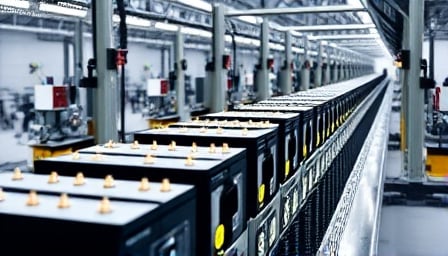Sunwoda Electronic Co Ltd: Riding the Lithium‑Ion Surge amid a Sector‑Wide Bull Run
Sunwoda Electronic, a Shenzhen‑listed specialist in lithium‑ion battery modules, has found itself at the nexus of several converging market dynamics that are reshaping the global battery landscape. With a market capitalization exceeding 54 billion CNY and a price‑earnings ratio of 35.49, the company’s valuation is tightly linked to the performance of the broader battery and electronics supply chains. Recent market activity—most notably a 14.91 % rise in the Wind Consumer Electronics Index since the beginning of August and a torrent of “20CM” trading in solid‑state battery (SSB) stocks—has amplified the spotlight on Sunwoda’s product portfolio.
1. Consumer Electronics Boom Fuels Demand for High‑Performance Batteries
The latest wave of product launches from giants such as Huawei and Samsung has pushed the consumer electronics sector into a new “new‑product release season.” Wind data reports a 3.47 % surge in the consumer electronics concept index on 5 September, with key constituents like 亿纬锂能 and 欣旺达 gaining over 16 %. Sunwoda’s core offerings—lithium‑ion battery modules for mobile phones, tablets, laptops, and power‑driven tools—are positioned to benefit directly from this uptick. Each new fold‑able phone or high‑resolution tablet demands more energy density and faster charging, conditions under which Sunwoda’s modules excel.
However, the company’s stock has not mirrored the exuberance of its peers. With a closing price of 29.40 CNY on 4 September—well below the 52‑week high of 30.30 CNY—investors remain cautious. The disparity suggests that Sunwoda’s earnings potential is still perceived as lagging, possibly due to its relatively higher valuation multiple and a lack of a distinct competitive moat in the crowded lithium‑ion market.
2. Solid‑State Battery Hype: A Double‑Edged Sword
On 5 September, the A‑share market witnessed a “stagnation” in the SSB sector, with more than 30 stocks breaking the 10 % threshold. The narrative is driven by policy‑led standards—China’s Ministry of Industry and Information Technology’s 2025‑2026 action plan—and the Chinese Automobile Engineering Society’s upcoming standards sessions on 10–11 September. Companies such as 金银河, 先导智能, and 天华新能 have recorded “20CM” daily limits, signaling institutional confidence in the next‑generation battery technology.
Sunwoda, though a formidable lithium‑ion player, has yet to announce a solid‑state portfolio. This omission is a strategic vulnerability. While its current product line serves mainstream applications, the rapid shift toward solid‑state chemistry—promising higher energy density, improved safety, and lower costs—poses a long‑term threat. If Sunwoda fails to pivot, it may lose market share to newer entrants that can integrate SSB technology into their offerings.
3. Renewable Energy and Energy Storage Synergies
The A‑share rebound on 5 September was further buoyed by the renewable energy corridor. Notable gains in the photovoltaic and wind sectors, coupled with the rise in the “solid‑state battery” group, underline a broader market consensus that clean‑tech infrastructure will dominate the next decade. Sunwoda’s product range extends beyond consumer electronics into electric bicycles, electric vehicles (EVs), and energy‑storage systems—domains that stand to benefit from the same tailwinds.
Investors should note, however, that Sunwoda’s exposure to these high‑growth segments is relatively modest compared to its core consumer‑electronics battery business. The company’s financials reflect a significant portion of revenue from mobile phone and tablet batteries, with only peripheral sales to EV and storage markets. A strategic reallocation of resources toward EV‑grade battery modules could unlock new growth avenues, but this requires capital investment and re‑engineering of production lines—an undertaking that may strain the company’s current cash flow and margin profile.
4. Funding Dynamics and Valuation Pressures
Sunwoda’s P/E ratio of 35.49 sits on the upper end for the sector, a figure justified only if the company can sustain a revenue growth trajectory of 15–20 % per annum. The recent stock market volatility—particularly the 2.01 % rise in the Shenzhen Composite and the 3.48 % surge in the ChiNext Index—has created a short‑term liquidity window that could be leveraged for expansion. Yet, the firm’s recent price trend, hovering near the 52‑week low of 14.95 CNY, indicates that market sentiment remains cautious.
The company’s IPO in April 2011 and subsequent listing on the Shenzhen Stock Exchange provide a stable capital base. However, Sunwoda must balance the need for R&D investment against the imperative to maintain dividend attractiveness for institutional investors, many of whom are now allocating capital toward high‑yielding SSB stocks that exhibit lower price volatility.
5. Conclusion: A Company at a Critical Juncture
Sunwoda Electronic sits at the intersection of two powerful forces: an expanding consumer electronics ecosystem demanding higher‑capacity lithium‑ion batteries, and an emerging solid‑state battery revolution that threatens to eclipse traditional chemistries. The company’s current valuation and stock performance reflect a market that is skeptical of its ability to diversify quickly enough to capitalize on the next wave of battery technology.
For investors, Sunwoda represents a high‑risk, high‑reward proposition. Those willing to endure short‑term volatility may find value in the company’s established supply chain and proven manufacturing capabilities. Conversely, a prudent strategy would involve monitoring Sunwoda’s R&D pipeline, assessing its strategic partnerships with automotive OEMs, and tracking its response to the SSB standards rollout. In a market where innovation dictates survival, Sunwoda must either innovate or be sidelined.
